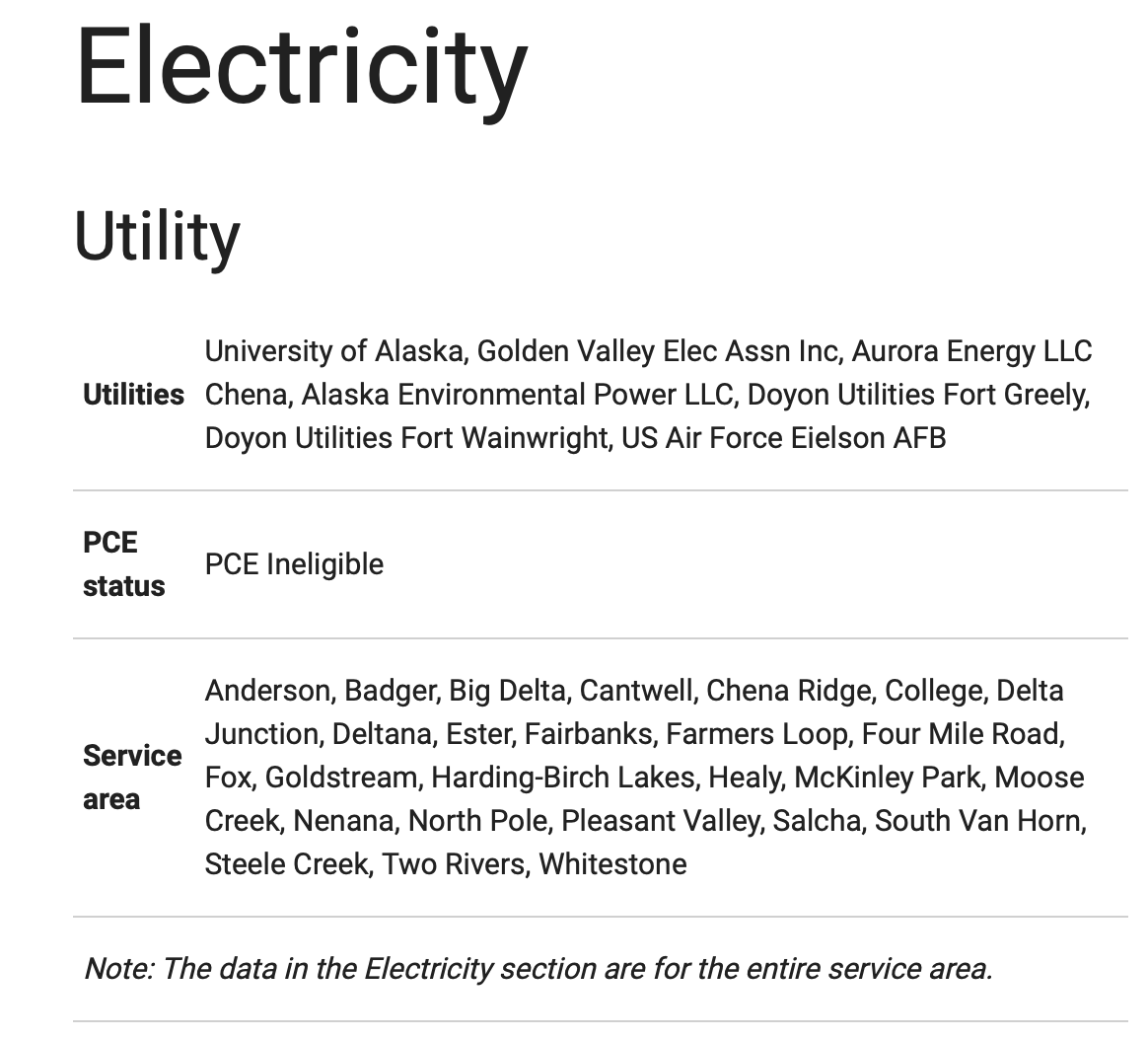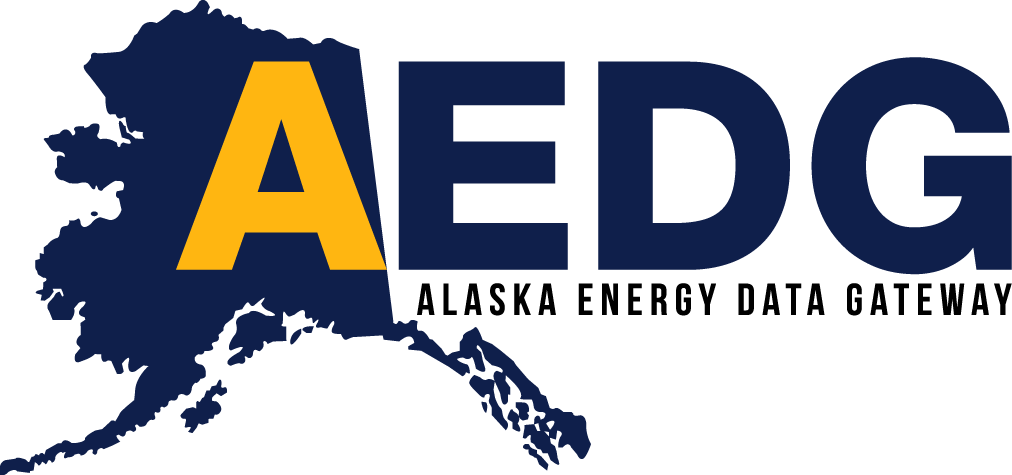Appendix B — Aurora Energy LLC Example
Single community, multiple utilities
To illustrate the questions that arise with utilities that serve multiple parts of the energy market and the relationships between Independent Power Producers (IPPs) and the Load Serving Entities that distribute power to customers, this page considers the case of Aurora Energy LLC in Fairbanks. It also illustrates the development of plants and operators in Fairbanks over time because knowing that history is important.
These questions were not addressed adequately by the previous version of AEDG. In the AEDG dashboard for Fairbanks, Aurora Energy is categorized as one of many electrical utilities and no mention is made of the other utilities that serve Fairbanks. Here is a screenshot of that display:

To add more context that can bee applied to AEDG v3, this page draws upon legal definitions and information from the Regulatory Commission of Alaska (RCA). Additional information came from subject matter experts Steve Colt and Mark Foster; their responses in an email exchange in Feb. 2025 have been edited here for clarity.
B.1 What is Aurora Energy LLC?
Aurora Energy is a company that owns and operates the coal fired power plant in downtown Fairbanks; it has also been called Aurora Power. This plant generates electricity, and it also generates heat which is distributed to customers in the downtown area.
Aurora Energy is regulated by the RCA (CPCN 520), which gives it “Authority to operate as an electric utility to furnish electric energy to Golden Valley Electric Association, Inc.,”. But there is another certificate (CPCN 119) that describes it as a public utility providing steam heat with a service area of “The corporate limits of the City of Fairbanks, Alaska, as of July 1, 1970.”
Therefore, Aurora Energy is both:
- a certificated utility that directly serves commercial and consumers rate payers in Fairbanks and receives payments from them, selling heat in a service territory defined by the network of steam [and hot water] pipes; and
- an IPP selling electricity to Golden Valley Electric Association (GVEA)
Aurora Energy is one of the successor entities to the Fairbanks Municipal Utilities System (FMUS) that served downtown Fairbanks for decades. FMUS also provided district heat through pipes, as steam. Coal fired power plants that generated heat and electricity were common across small campuses around the Northern United States. A similar entity was Anchorage Municipal Light and Power which served downtown Anchorage.
B.1.1 What is Aurora Energy’s relationship to Usibelli Coal?
Aurora Energy is listed as a customer of Usibelli Coal. Their 2011 Financial Statement filed at the RCA says that “The Company has similar ownership as Usibelli Coal Mine, Inc. (UCM), sole supplier of coal to the plant.” The GEM wiki says “It is a private company, owned by Joseph E. Usibelli, Sr., Joseph E. Usibelli, Jr., and Rosalie Whyel.”
B.2 What is Golden Valley Electric Association (GVEA)?
The Golden Valley Electric Association (GVEA) is a non-profit electric cooperative membership corporation whose mission is to “safely provide its member-owners with reliable electric service, quality customer service, and innovative energy solutions at fair and reasonable prices.” GVEA incorporated in 1946, and in about 1997, GVEA acquired the electricity transmission and distribution assets from FMUS and some of its generation assets.
GVEA acquired the Frame 5 diesel fired generating units that were stationed adjacent to the FMUS Chena Power Plant from FMUS. But GVEA did not acquire the big coal plant on the Chena river; instead Aurora Energy came into being as an IPP, acquired that coal plant, and operates it now.
GVEA is the final seller of electricity, or “Load-Serving Entity” (“LSE”), serving all of Fairbanks with some exceptions. GVEA only covers customers who have or pay for electric line extensions to their property/facilities. A number of customers within GVEA’s service territory continue to self-generate electricity in view of the expense of line extension costs. And for historic reasons, UAF and the military bases generate their own power (see below). GVEA’s role is convoluted: sometimes selling some electricity to the bases, sometimes buying electricity from UAF, and probably some other interesting behaviors.
GVEA is regulated by the RCA (CPCN 13) and has a service area that covers Fairbanks and beyond.
Additional info:
- Henri Dale, retired from GVEA, will have details on GVEA’s acquisitions.
- Wight, P. (2025). Electrifying Alaska’s Railbelt: A Generation and Transmission History, 1904-2024. Zenodo. https://doi.org/10.5281/zenodo.14908275
- Sources of Power, a published list of where GVEA purchased power from. As of April 2025, the list includes 25 MW of power from Aurora Energy, but nothing from UAF and no natural gas generation from other railbelt utilities since February 2024.
- 2023 Annual Report CPCN 13 for Golden Valley Electric Association, Inc. which includes FERC Form 1 on purchased and sold power
B.3 Are there other relevant utilities?
Fairbanks has more distributed power generation than other communities in part because of the evolution of the distribution of the power plants developed at University of Alaska Fairbanks, Ft. Wainwright, Eielson Air Force Base, and later additional GVEA operated power plants using diesel, HAGO, and naphtha generation resources at the North Pole refinery associated with completion of the Trans-Alaska Pipeline System (TAPS) in 1977. In addition, there are, or have been, other energy utilities besides electrical utilities:
- The Fairbanks Interior Gas Utility (IGU) is certificated to sell natural gas (CPCN 753)
- Fairbanks Natural Gas LLC (CPCN 514) used to be the gas utility in the city of Fairbanks, but it is inactive now.
- The University of Alaska Fairbanks’s coal plant that makes both electricity and heat
- Doyon Utilities provides electric utility service for Fort Wainwright in Fairbanks (CPCN 726)
- Doyon Utilities also serves as a heat utility for Fort Wainwright (CPCN 725)
- Fairbanks is connected to the Railbelt and so purchases power from other connected utilities.
B.3.1 A note on technology
For decades, Fairbanks used smaller scale wood and nascent oil/diesel. These were replaced with combined heat-power plants that imported stoker fired traveling grate coal feeds into a boiler technology adapted from the shipping industry that later converted to oil. Fairbanks imported this relatively efficient form of heat-power energy production roughly contemporaneous with WWII and the influx of federal Department of Defense money. The steam distribution systems also provided humidification in the dry winter months. Over the years there has been some effort to replace/complement steam distribution loops with hot water distribution loops.
B.4 Categories
Types of utilities in Alaska are listed in Section A.1.2. For his update to the Alaska Energy Statistics Workbooks, Neil McMahon uses an overarching category called “Operator”, of which utilities are one type. The types of operators are:
- Public Electric Utility
- Private Electric Utility
- Electric Co-op
- Subsidiary
- Independent Power Producer
- Military
- Industrial
- Joint Action Agency of the State of Alaska
- Political Subdivision of the State
